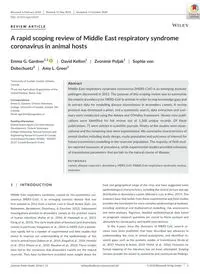
2018 A rapid scoping review of Middle East respiratory syndrome coronavirus in animal hosts PDF
Preview 2018 A rapid scoping review of Middle East respiratory syndrome coronavirus in animal hosts
Zoonoses Public Health. 2018;1–12. wileyonlinelibrary.com/journal/zph | 1 © 2018 Blackwell Verlag GmbH 1 | INTRODUCTION Middle East respiratory syndrome, caused by the eponymous cor‐ onavirus (MERS‐CoV), is an emerging zoonotic disease that was first isolated in 2012 from a human case in Saudi Arabia (Zaki, van Boheemen, Bestebroer, Osterhaus, & Fouchier, 2012). Subsequent investigations pointed to dromedary camels as the putative source of human infections (Azhar et al., 2014; Al Hammadi et al., 2015; Farag et al., 2015). The early implication of livestock (and dromedary camels in particular, Haagmans et al., 2014) in MERS‐CoV transmis‐ sion rapidly led to a number of experimental and field studies that aimed to improve our understanding of the epidemiology of this virus in animal hosts (Adney et al., 2014; Alagaili et al., 2014; Hemida et al., 2013; Meyer et al., 2015; Reusken et al., 2013). These studies have led to the consensus that dromedary camels are the natural reservoir. They have furthermore provided some insight about the host and geographical range of the virus and have suggested some epidemiological characteristics, including the clinical picture and age distribution in dromedary camels (Wernery, Lau, & Woo, 2017). The evidence base that builds from these experimental and field studies provides the foundation for more complex epidemiological analyses, including statistical and mathematical modelling, risk assessments and meta‐analyses. Rigorous, detailed epidemiological data based on pragmatic research questions are crucial to these analyses and ultimately for sound policy and health interventions. In the 6 years since the discovery of MERS‐CoV, several re‐ views have been published that have described key advances in understanding the virus in animal populations, and identified re‐ search gaps, such as the zoonotic modes of transmission (Arabi et al., 2017; Mackay & Arden, 2015; Mohd, et al., 2016). However, no formal mapping of the literature has yet been attempted. Scoping reviews provide the means to summarize and communicate findings, Received: 6 February 2018 | Revised: 31 May 2018 | Accepted: 11 October 2018 DOI: 10.1111/zph.12537 R E V I E W A R T I C L E A rapid scoping review of Middle East respiratory syndrome coronavirus in animal hosts Emma G. Gardner1,2 | David Kelton1 | Zvonimir Poljak1 | Sophie von Dobschuetz2 | Amy L. Greer1 1University of Guelph, Guelph, Ontario, Canada 2Food and Agriculture Organization of the United Nations, Rome, Italy Correspondence Emma G. Gardner, Ontario Veterinary College, University of Guelph, Guelph, ON, Canada. Email:
